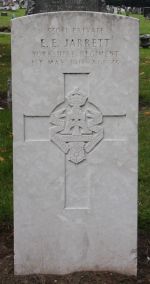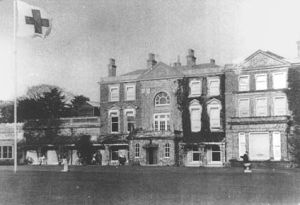|
|
| Home Topics Memorials Miscellany Transcripts References Family History Glossary Latest Beeston Blog About us | Site Search |
|
Ernest Edward Jarrett was born in Beeston, Nottinghamshire in 18821, the second of three children and only son, of Robert James (b. c1855, Wisbeach, Cambridgshire) and Eliza (b. c1854, Coventry, Warwickshire, née Turrell). The couple had settled in Beeston, first at 48 (now 82) High Road after their marriage in 1879. Later they moved to Lower Regent Street, Beeston, with Robert working as a letter carrier at first. By 1901 the family, including all four of their children, was living at 30 Lower Regent Street, Beeston with Robert working as a tin plate worker and Ernest working as a lace threader2. Sadly, the census records that Eliza had recently become blind. By 1911, Ernest's younger sister, May Elizabeth, had married and moved3 and the family had moved to 24 Lower Regent Street, Beeston, Eliza was now recorded as totally blind and Robert had left to live in Nottingham. Ernest, now 28, continued to work as a threader in a local lace factory4. Now with an absent father and a mother who was blind, much of the responsibility of the household now fell on Ernest. In these circumstances, it is perhaps understandable that he was not amongst those who enlisted so enthusiastically in the early months of the war. By 1916, however, the number of men volunteering for service was diminishing and was not meeting the relentless demand from the Western Front and the Government was looking for ways to fill the gap. The Derby Scheme, which introduced canvassing for volunteers had still not persuaded the required numbers and the Military Service Act was now enacted which meant that, from March 1916, all single men aged between 18 and 41 (with some exceptions) would be automatically conscripted. Ernest appears to have enlisted in April 1916, joining the 7th Northumberland Fusiliers for training5. Although we have no record of exactly when, it seems that, Ernest was transferred to 10th Battalion Yorkshire Regiment (Alexandra Princess of Wales Own) at some point, probably when he was sent to France to reinforce the battalion which had been on the Western Front since September 1915. As part of 62nd Brigade in the 21st Division, it had been involved in the Battle of Loos and the Battle of the Somme. In 1917, the battalion - probably now including Private Jarrett - saw action during the Battles of the Scarpe, experienced the horrors of the various phases of the Third Battle of Ypres (widely known as 'Passchendaele') and took part in the Cambrai operations. On 19 February 1918, the battalion was disbanded and its personnel transferred to other battalions of the Regiment. Private Jarrett joined 5th Battalion, part of 150th Brigade of 50th Division6. In early March 1918, the battalion was near Amiens, undergoing training. A major attack by the enemy had been expected for some time as enemy positions had been strangely quite and the early days of the month had been spent in training. Then, on 21st March, the German Army launched its Spring Offensive from the Hindenburg Line with the objective of ending the war before American troops and resources could tilt the balance towards the Allies. The objective was to smash through the Allied lines, push the British forces into the sea and to cut off their supply lines by seizing the ports. On this first day the enemy had attacked heavily after an intense bombardment and those facing their attack had suffered heavy losses and had been forced to fall back when the line was pieced. The enemy had made considerable gains and units were quickly deployed to try to stop the breakout. 5th Battalion was hastily deployed to meet the German attach east of Amiens and fought a ten day rearguard action to try to stem the hordes of German storm troopers. It was a period of much confusion and heavy casualties - 372 in 5th Battalion - and the men that remained were brought together as a composite battalion of 560 men - 140 of whom were from 5th Battalion. Finally, on 1st April, these surviving but exhausted men were able to take some rest in the suburbs of Amiens. The German breakout had been stopped but there was more to come. On 9th April the German Army, still confident that it could break through to gain control of the ports, launched the Georgette Offensive - also called the Battle of the River Lys.10. Desperately, the battalion played its part in preventing an enemy breakthrough but, sadly, suffered even more casualties. At some point in these battle, either in late March or early April, Private Jarrett was seriously injured7. As a wounded man, Private Jarrett would have first been taken to the Regimental Aid Post just behind the front line where conditions were such that only basic wound dressing and first aid was possible. As a seriously wounded man, he would then be taken to an Advanced Dressing Station for further treatment in an area that was further behind the front line. From there, the more seriously wounded - such as Private Jarrett - would be moved - perhaps by horse-drawn transport - to a Field Ambulance - a mobile medical unit where medical officers and nurses were available to provide emergency treatment. The next step would be to move those needing further treatment to a Casualty Clearing Station where a full range of medical facilities were available. These units were positioned several miles behind the front line, usually close to railway lines or waterways so that onward evacuation could be made easier. From there, the most seriously wounded would be moved, by train or barge, to one of the base hospitals, probably one of the General Hospitals, near to the coastal ports. Where necessary, as in the case of Private Jarrett, a hospital ship would take the casualty across the Channel where an ambulance train or motor ambulance would move him to one of the many military hospitals that had been set up, often in stately homes.
Private Jarrett was posthumously awarded the British War Medal and the Victory Medal10. His Army financial effects of £15 4 5d, together with his War Gratuity of £9, were paid equally between his mother and his two sisters on 23 June 192011. The years following the war would have been particularly hard for the members of the family that were left. However, Ernest's married sister and her husband, May & James Hazlewood, moved to live at 24 Lower Regent Street12, where they cared for Eliza - who was to live until the age of 8513. Florence, Ernest's other sister, never married but went to live in Nottingham where she appears to have made a living as a dressmaker, She died there in 1961, aged 8214. The whereabouts of Robert, Ernest's father, after 1910 is not certain but it appears that he died in Nottingham in 1934, aged 7915. Footnotes 1His birth was registered in Basford Registration District (of which Beeston was part) in Q3/1882(Ref 7b 151). 2Beeston, Notts, 1901 Census, Piece 3153 Folio 140. Ernest's siblings were Florence Maud (1880-1961) and May Elizabeth (b. c1887) 3May Elizabeth Jarrett married James Samuel Hazlewood in Q3/1905 in Basford Registration District (of which Beeston was part). 4Beeston, Notts, 1911 Census, Piece 20432 RD429, SD3, ED7, Schedule 140. 5As his Army Service Record has not survived, his attestation date has been calculated based on the amount of his War Gratuity. His early attachment to the Northumberland Fusiliers is from his entry in 'Soldiers Died in the Great War' (which records his then Service Number as 3527, and from medal records which record his then Service Number as 4248. 6Ernest's attachment to 10th Battalion Yorkshire Regiment and later transfer to 5th Battalion is recorded in the Medal Rolls. The brief outline of the deployment of 10th Battalion is based on that on the Forces War Records website (www.forces-war-records.co.uk/units/5169/alexandra-princess-of-waless-own-yorkshire-regiment). 7This summary account of the battalion's deployment in March and April 1918 draws on a much fuller account which may be found at www.ww1-yorkshires.org.uk/frank-and-sam-maltby/maltby-cousins-08.htm. 8This description of Quex House Auxiliary Military Hospital draws on a much fuller account which may be found at www.vlib.us/medical/quexhosp/quex.htm. 9His death was registered in Thanet Registration District (of which Birchington was part) in Q2/1918 (Ref 2a 1228) - age 35 10Details from Ernest's Medal Card and the Medal Rolls - available on ancestry.com. 11Details from "Army Register of Soldiers' Effects, 1901-1929" - available on ancestry.com. 12May and James were living at this address in 1921 and were still there in 1930 (as was Eliza Jarrett) (Electoral Rolls). The address later became 213 Regent Street, 13Her death was registered in Basford Registration District, of which Beeston was part, in Q2/1939 (Ref 7b 166) - age 85. 14At the time of the 1939 Registration she was living alone, described as a dressmaker, at 2 Westminster Villas, Nottingham. Her death was registered in Nottingham Registration District in Q2/1961 (Ref 3c 377) - age 82. 15The reasons for Robert's departure are not known. It does appear that he died in Nottingham Registration District in Q2/1934 (Ref 7b 414) - age 79. |
|
|||||||||||
|
|
|||||||||||||

 In this way, Private Jarrett was admitted to the Auxiliary Military Hospital that had been created at Quex House, near Birchington-on-Sea, in the Isle of Thanet, Kent (Shown Right). Its owners, Major and Mrs Powell Cotton had made their home available to the Red Cross in
1914, very shortly after the outbreak of war. It was staffed by the Birchington Voluntary Aid Detachment with Mrs H B Powell Cotton as its commandant. The hospital could accommodate 45 patients and was to care for a total of 1241 patients during the
war. It is said that only three died while in its care8. Sadly, on May 1st 1918, despite every effort by the medical team, Private Jarrett was one of those who died from his wounds9. His body was returned to Beeston and he was buried in the
cemetery there. A Commonwealth War Graves Commission memorial stone marks his grave.
In this way, Private Jarrett was admitted to the Auxiliary Military Hospital that had been created at Quex House, near Birchington-on-Sea, in the Isle of Thanet, Kent (Shown Right). Its owners, Major and Mrs Powell Cotton had made their home available to the Red Cross in
1914, very shortly after the outbreak of war. It was staffed by the Birchington Voluntary Aid Detachment with Mrs H B Powell Cotton as its commandant. The hospital could accommodate 45 patients and was to care for a total of 1241 patients during the
war. It is said that only three died while in its care8. Sadly, on May 1st 1918, despite every effort by the medical team, Private Jarrett was one of those who died from his wounds9. His body was returned to Beeston and he was buried in the
cemetery there. A Commonwealth War Graves Commission memorial stone marks his grave.